Modes of individuation in the digitalized present: connection, interaction and personalization
Un modelo explicativo de la individuación en la comunicación digital
DOI:
https://doi.org/10.37467/revtechno.v11.4388Keywords:
communication, Individuation, Connection, Interaction, Personalization, DigitizationAbstract
Individuation as a process linked to the future of the human being is closely linked to communication, which according to Simondon (2016) is organized on three levels: ethological, ecological and psychological, such a theoretical framework is the foundation that allows us to understand the it forms of individuation in digital environments and in that sense the digital communication model of the rixomatic web 1.0, social 2.0, semantic 3.0 and ubiquitous 4.0. it is constituted in a correlative way in a hermeneutical and explanatory model of such process of individuation in digital communication.
References
Beck, U. (2017). La metamorfosis del mundo. Paidós.
Berners-Lee, T. (2000). Tejiendo la red. El inventor del World Wide Web nos descubre su origen. Siglo XXI. Campillo, A. (2018). Mundo, Nosotros, yo. Ensayos cosmopoliéticos. Herder.
BBC Documentales (02 de junio de 2020) La Revolución virtual: El precio de lo gratuito [Archivo de Video] YouTube. https://www.youtube.com/watch?v=DDqa1UiLl6Y
Castro, F. (2020). Tecnología, disciplina y control: Un escenario para el retorno de la idea de progreso desde las transformaciones del capitalismo. En R. Feltrero. (Ed.), La enseñanza de las ciencias desde la pedagogía social: el paradigma educativo STEM como modelo para la educación integral de ingenieros y ciudadanos. GKA Ediciones.
Castro, F. (2021). El presente que nos habita: análisis de la comunicación digital y de la sociedad contemporánea. Fondo Editorial Colegiatura.
Chateau, J. (2016) Presentación Comunicación e información de Simondon. En Comunicación e información. Cactus.
D´Amato, P. (2020) Smithereens and the Economy of Attention: ¿Are We All Dopamine Addicts? En K. Johnson. (Ed.), Black Mirror and Philosophy: Dark Reflections. John Wiley & Sons.
Deleuze, G. y Guattari, F. (2000). Rizoma. Coyoacan.
Honneth, A. (2018). Reconocimiento: Una Historia de las ideas europea. Ediciones Akal Mexico. Lévy, P. (1998). Qué es lo virtual. Paidos.
Lévy, P. (2007). Inteligencia colectiva: por una antropología del ciberespacio. OPS. Martín Barbero, J. (2010) De los medios a las mediaciones. Anthropos.
Maturana, H. & Varela, F. (2004). De máquinas y seres vivos: autopoiesis: la organización de lo vivo. Lumen. Montoya, J. (2019). La individuación y la técnica en la obra de Simondon. Aula.
O´Reilly, T. (2006). Qué es Web 2.0. Patrones del diseño y modelos del negocio para la siguiente generación del software. Telefónica.
Orlowski, J. (2020) El dilema de las redes sociales. [Documental]. Netflix. Rheingold, H. (2009) Multitudes inteligentes. La próxima revolución social. Gedisa
Rodríguez, P. (2020). Las palabras en las cosas. Saber, poder y subjetivación entre algoritmos y biomoléculas. Cactus. Rosa, H. (2019). Resonancia. Katz Editores.
Sadin, E. (2018). La Humanidad aumentada. Caja Negra. Simondon, G. (2016). Comunicación e información. Cactus.
Wu, T. (2020). Comerciantes de atención: La lucha Épica por entrar en nuestra cabeza. Capitan Swing.
Downloads
Published
How to Cite
Issue
Section
License
Those authors who publish in this journal accept the following terms:
- Authors will keep the moral right of the work and they will transfer the commercial rights.
- After 1 year from publication, the work shall thereafter be open access online on our website, but will retain copyright.
- In the event that the authors wish to assign an Creative Commons (CC) license, they may request it by writing to publishing@eagora.org







